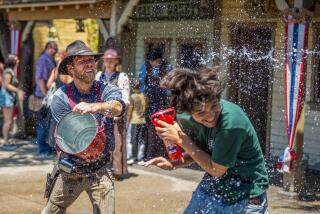At Alcatraz, the walls speak with real voices
- Share via
SAN FRANCISCO — Darwin Coon is constantly reminded of his time on Alcatraz. The former bank robber can see the notorious island prison from just outside his front door in the city’s North Beach district.
Coon remembers thinking he’d never get out alive, and was among the last inmates to leave when U.S. Atty. Gen. Robert Kennedy closed the federal penitentiary in 1963. Years later, when a niece asked him to show her his old cell, he responded: “I never wanted to go back there.”
Now 74, Coon finally did return, and his recollections of daily life on “The Rock” are part of an updated audio tour unveiled this month as part of a $3.5-million renovation aimed at making Alcatraz more accessible.
The improvements also include an elevator that gives access to the elderly and disabled and allowed the National Park Service to open another floor of the prison.
Visitors now enter Alcatraz the same way new inmates did: through the dank shower room where “fresh fish” were hosed off before being issued jail clothes.
Getting Coon and the others to share their stories was vital because many Alcatraz alumni are dying, said Rich Weideman, spokesman for the Golden Gate National Parks Conservancy, a nonprofit that helps preserve Bay Area parks.
Updating the 20-year-old prison tour also provided an opportunity to inject new perspectives that had previously been ignored.
“In the housing of inmates at Alcatraz it was deemed necessary to keep blacks away from whites,” Phillip Bergen, a captain of the guards at Alcatraz, says on the audio tour.
Although other federal prisons integrated their inmate populations, Alcatraz never did.
“They tried [integration], and they opened up, and they had such a high population of hostile rednecks and such a low population comparatively of blacks that they soon found out they couldn’t do it,” Bergen says.
Of the 100 or so guards who served, only a few blacks were hired, including tour contributor Ron Battles.
He says that life on The Rock mirrored American culture of the 1950s and that he faced persistent discrimination from white colleagues.
Listening to stories from inmates and guards while strolling through the cold, gray prison has long been part of the experience that draws 1.3 million visitors to Alcatraz each year. The original, groundbreaking audio tour was created in 1987.
“It was the first major audio tour in a historic site to use first-person” stories, Weideman said. “It changed the audio-tour industry.”
In addition to providing a multicultural perspective on the Alcatraz experience, the updated tour highlights guards’ stories in greater detail than before.
The new features at Alcatraz include displays in the museum of artifacts that have never been on public view. A collection of shivs, or knives honed secretly by prisoners from kitchen utensils or smuggled scrap metal, shows how dangerous the prison was for guards.
The park service and conservancy have also uncovered remnants of the island’s pre-prison past, including gardens from the 1800s when the island was a military fort. The gardens were later tended by guards and inmates being rewarded for good behavior.
But Alcatraz was designed to break down its inhabitants, and those who lived to tell their tales don’t mince words when describing their lives on The Rock.
“Everybody wants to be an individual,” former inmate Jim Quillen says. “They want to be a human, and you weren’t at The Rock.”
More to Read
Sign up for The Wild
We’ll help you find the best places to hike, bike and run, as well as the perfect silent spots for meditation and yoga.
You may occasionally receive promotional content from the Los Angeles Times.






